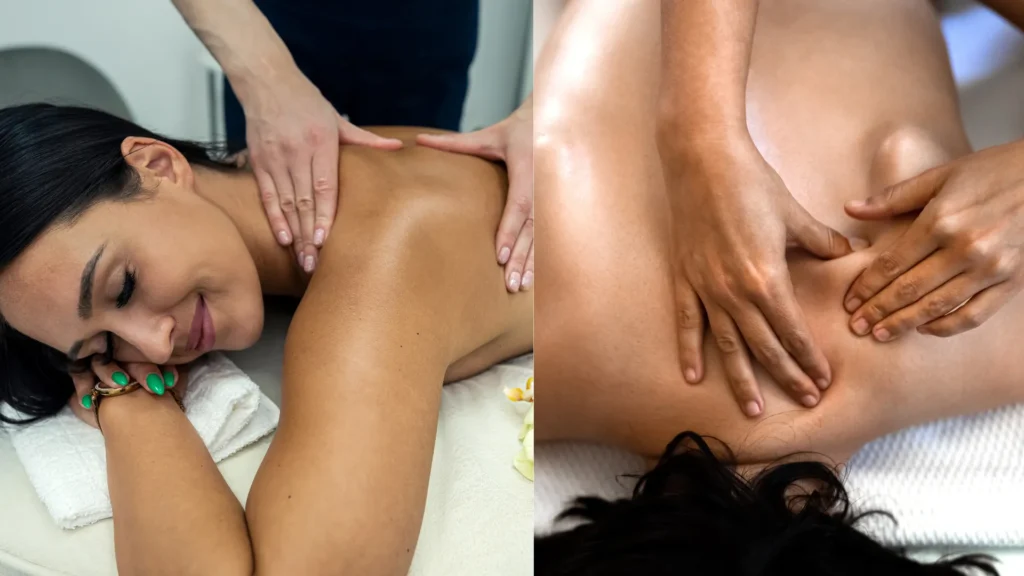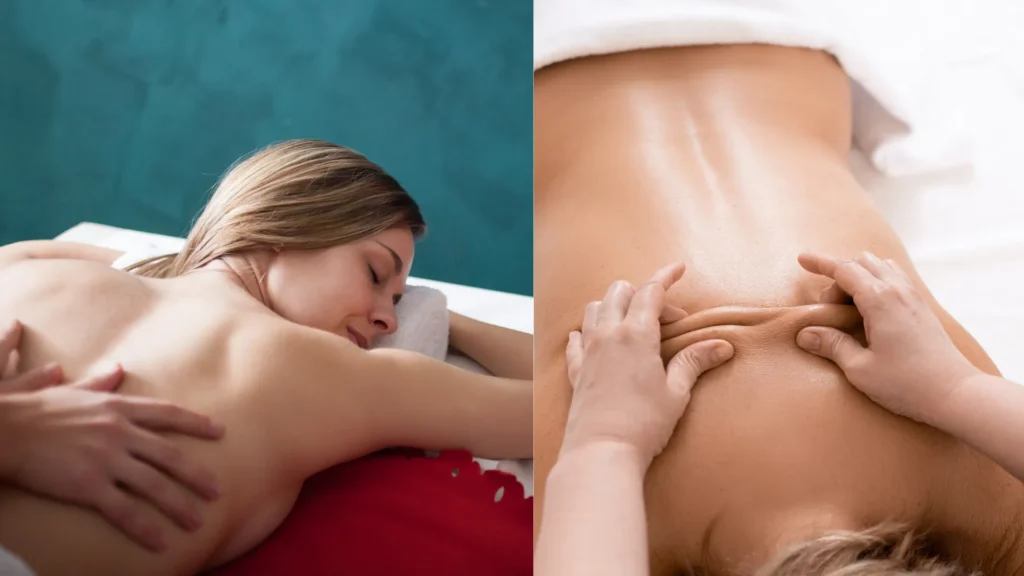In this comprehensive blog post on “The Difference Between Swedish and Deep Tissue Massage,” you’ll discover:
- The fundamental principles and techniques behind Swedish massage.
- A deep dive into the therapeutic world of Deep Tissue massage.
- Key insights on choosing between these two popular massage techniques based on client needs.
Are you a Client or a therapist looking to enhance your skill set, or are you curious about the distinct benefits of these two popular massage types? Either way, you’re in for a treat! Get ready to peel back the layers of these healing arts and uncover the secrets that will enrich your understanding and elevate your practice or personal wellness journey.
Jump To:
Basics of Swedish Massage
Swedish massage is like the gentle lullaby of the massage world. It’s one of the most well-known types of massage, celebrated for its soothing and relaxing qualities. Originating from (you guessed it!) In Sweden, this technique has become a global favourite, offering a gentle touch that’s perfect for first-timers or those seeking a more mellow experience.
The Techniques That Make It Special
Swedish massage is like an orchestra of movements, each playing its part to create a symphony of relaxation.
Here’s what makes it unique:
- Effleurage: These are long, gliding strokes, kind of like painting broad strokes on a canvas, but with a gentle, soothing touch.
- Petrissage: This technique involves kneading the muscles. Picture a baker lovingly preparing dough – it’s kind of like that, but for your muscles.
- Tapotement: Think of a rhythmic tapping or drumming. It’s not a rock concert in your back, but a gentle wake-up call for your muscles.
- Friction: Here, the therapist uses more pressure to create heat, helping to release tension. It’s like a warm hug for your deeper muscles.
- Vibration: Gentle, shaking movements that can feel surprisingly soothing, like a soft breeze swaying through the leaves.

The Benefits: More Than Just Relaxation
While Swedish massage is often associated with relaxation, it’s like a multi-tool for your health.
Here’s what it can do:
- Stress Relief: It’s like a mini-vacation for your mind and body.
- Improved Circulation: Think of it as a traffic control system, helping your blood flow smoothly through your body.
- Enhanced Well-being: It’s not just about feeling good physically; it’s about lighting up your mood too!
NOTE: If you want to get more details about this Massage, check out my following guide on: “Introduction to The Swedish Massage.“
Ideal for Whom?
Swedish massage is the go-to choice for:
- Massage Newbies: Swedish is like the friendly welcome mat if you’re new to the world of massage.
- Stress Busters: For those looking to unwind and de-stress, it’s like a peaceful retreat.
- The ‘Just Because’ Crowd: Sometimes, you don’t need a reason other than wanting to feel good!
So, It’s more than just a series of strokes; it’s a pathway to tranquillity and wellness. Whether you’re a therapist looking to refine your skills or someone simply exploring the art of massage, understanding Swedish massage is a great place to start.

Basics of Deep Tissue Massage
Now, let’s talk about the deep stuff – Deep Tissue Massage. This technique is like the deep-sea diver of massages, going further and deeper into the muscle than Swedish massage. It’s not just about relaxation; it’s about transformation and healing.
Deep tissue massage is known for its intense pressure and targeted approach, making it a favourite for athletes and those dealing with chronic muscle tension.

The Techniques That Dive Deep
Deep Tissue Massage has its own unique set of moves:
- Slow Strokes: Imagine a slow-motion movie scene, where every movement is deliberate and intense. That’s how these strokes work, focusing deeply on problem areas.
- Deep Finger Pressure: This is where the therapist uses their fingers to really get into those knots. It’s like having a skilled sculptor working out the tensions in your muscles.
- Stripping and Friction: These techniques involve deep, gliding pressure along the muscle fibres, kind of like ironing out the creases in a shirt, but for your muscles.
The Benefits: Beyond the Surface
Deep Tissue Massage goes beyond relaxation.
Here’s what it offers:
- Chronic Pain Relief: It’s like a warrior battling against the persistent pain in your body.
- Recovery and Healing: Ideal for those recovering from injuries or with muscle damage.
- Improved Posture: By targeting deeper layers of muscle, it helps in realigning things down there.
NOTE: If you want to get more details about this Massage, check out my following guide on: “Introduction to The Deep Tissue Massage.“
Ideal for Whom?
Deep Tissue Massage is a great fit for:
- Athletes and Fitness Enthusiasts: Like a pit-stop for those constantly pushing their physical limits.
- The Chronic Pain Club: For those who’ve been bearing the brunt of ongoing pain and muscle tension.
- Post-Injury Recovery: If you’re on the mend from an injury, this massage is like a trusted friend helping you along the way.
Deep Tissue Massage isn’t just a massage; it’s a journey to the deeper realms of muscle and tissue. It’s about targeted, intentional relief that aims to restore and rejuvenate at a deeper level. For therapists, mastering this technique means being able to offer more than just a relaxing experience – it’s about providing a healing touch.

Key Differences Between Swedish and Deep Tissue Massage
Swedish and Deep Tissue massages are like two different musical genres, each with its unique rhythm and style.
Let’s break down their key differences:
Techniques
Swedish Massage: It’s like a gentle symphony – soothing and harmonious. The movements are smooth, flowing, and rhythmic, perfect for a serene experience.
Deep Tissue Massage: This is more like an intense guitar solo. The strokes are deliberate and focused, digging deep into the muscle layers.
Pressure
Swedish Massage: Think of a light, feathery touch. The pressure is gentle, and designed to relax and soothe.
Deep Tissue Massage: Imagine a strong, firm grip. The pressure is deep and penetrating, aimed at releasing deep-seated muscle tension.
Target Outcomes: Relaxation vs. Therapeutic
The goals of these two massages are as distinct as their techniques:
Swedish Massage:
Goal: It’s all about relaxation and general well-being. Picture yourself drifting away on a cloud of tranquillity.
Benefits: Stress relief, improved circulation, and a sense of overall happiness.
Deep Tissue Massage:
Goal: This one’s a problem solver, targeting specific areas of tension and chronic pain.
Benefits: Relief from chronic pain, reduced stiffness, and better mobility.
Who Should Choose What?
Knowing which massage to pick is like choosing the right tool for the job:
Swedish Massage:
Best For: Those seeking relaxation, stress relief, or a gentle introduction to massage. It’s like a warm, comforting embrace for your body and mind.
Deep Tissue Massage:
Best For: Individuals with chronic pain, athletes, or anyone with deep-seated muscle tension. Think of it as a focused, therapeutic intervention for your muscles.
Usage in Therapy: A Therapist’s Perspective
As a therapist, it’s crucial to understand when and why to use each technique:
Swedish Massage: Ideal for clients seeking relaxation or general body care. It’s like offering a peaceful retreat.
Deep Tissue Massage: Best for clients with specific issues like chronic pain or injury recovery. It’s like being a muscle detective, getting to the root of the problem.
Swedish and Deep Tissue massages are both fantastic in their own right, like two different flavours of ice cream. One offers a gentle, soothing experience, while the other provides a deep, therapeutic touch.
As a therapist, knowing these differences helps in guiding clients towards the massage that best suits their needs. And for clients, understanding these distinctions means making informed choices for your wellness journey.
Therapist’s Role and Considerations
As therapists, it’s crucial to play the role of a discerning guide, helping clients navigate their way to the right massage choice. Here’s how:
Understanding the Client’s Story
Listen Actively: Just like a detective listens for clues, we as Therapists pay close attention to what the client says about their pain, stress levels, and lifestyle.
Health History: A quick look at your health background can be enlightening. It’s like piecing together a puzzle to see the bigger picture.
Final Thoughts The Difference Between Swedish and Deep Tissue Massage
As we wrap up our journey through the soothing waves of Swedish massage and the deep paths of Deep Tissue massage, let’s take a moment to reflect on what we’ve learned. Understanding the nuances of these two popular massage techniques is more than just a skill for therapists – it’s a way to open doors to better health and well-being for our clients.
Recap of the Key Differences between Deep Tissue Massage and Swedish Massage
Swedish Massage: A gentle, rhythmic dance that soothes the soul and relaxes the body. It’s like a gentle breeze on a calm sea, perfect for de-stressing and rejuvenation.
Deep Tissue Massage: A deep, intentional journey into the muscles, targeting chronic pain and tension. It’s like a focused expedition, uncovering and healing the deeper layers of muscle discomfort.
Whether you’re a seasoned therapist or someone exploring the benefits of massage, understanding these differences is crucial. It empowers therapists to make informed decisions about treatment plans and enables clients to choose the path that best aligns with their wellness journey.
Massage therapy, in its various forms, is more than just a temporary escape from life’s stresses. It’s a key tool in maintaining physical health, mental well-being, and overall quality of life. Whether it’s the calming strokes of Swedish massage or the therapeutic pressure of Deep Tissue, each technique has its unique place in the world of healing.






